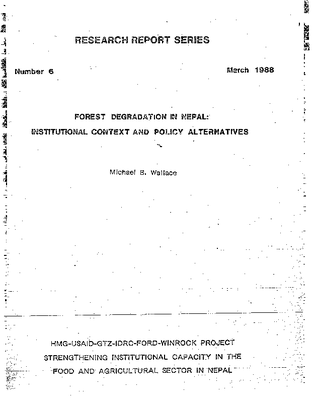Forest degradation in Nepal: Institutional context and policy alternatives
In Nepal, forest resources are not meeting subsistence demands for fuelwood and fodder. Official forest policies have historically sought profit for the central government, but have changed since 1977 in recognition of the government's inability to manage the forests, the survival needs of rural people, and the success of communities in managing shared forests. Most recently, policies have emphasized villager participation as the key to successful forest management. Although the policy rhetoric has changed, implementation has been difficult in part because many rural people do not trust government foresters and policies are often unclear or conflicting. Moreover, the adoption of new forest management styles that require significant investment are perceived as risky by rural people because, historically, land tenure has not been secure. Current policy reforms may not enable the satisfaction of Nepal's subsistence needs. The author provides a model to assess future policy alternatives in the context of community forestry. He recommends a mixed strategy that incorporates improved forest management with technologies such as efficient stoves. The author notes that villagers' perceptions of incentives and risks and the ability of all parties to learn from mistakes and successes of forestry projects will be key in the progress of effective and responsible forest management in Nepal.
https://biodiversitylinks.org/library/resources/rmp/library/content/tools/community-based-natural-forest-management-USAID-Lessons-Learned/cbnfm/USAID-BDB-cd-2-data/forest-degradation-in-nepal-institutional-context-and-policy-alternatives/view
https://biodiversitylinks.org/library/resources/rmp/library/content/tools/community-based-natural-forest-management-USAID-Lessons-Learned/cbnfm/USAID-BDB-cd-2-data/forest-degradation-in-nepal-institutional-context-and-policy-alternatives/@@download/image/image.png
File
Forest degradation in Nepal: Institutional context and policy alternatives
Author(s):
Michael B.Wallace
Publication Date: 1988
Location: Nepal
DOWNLOAD FILE
In Nepal, forest resources are not meeting subsistence demands for fuelwood and fodder. Official forest policies have historically sought profit for the central government, but have changed since 1977 in recognition of the government's inability to manage the forests, the survival needs of rural people, and the success of communities in managing shared forests. Most recently, policies have emphasized villager participation as the key to successful forest management. Although the policy rhetoric has changed, implementation has been difficult in part because many rural people do not trust government foresters and policies are often unclear or conflicting. Moreover, the adoption of new forest management styles that require significant investment are perceived as risky by rural people because, historically, land tenure has not been secure. Current policy reforms may not enable the satisfaction of Nepal's subsistence needs. The author provides a model to assess future policy alternatives in the context of community forestry. He recommends a mixed strategy that incorporates improved forest management with technologies such as efficient stoves. The author notes that villagers' perceptions of incentives and risks and the ability of all parties to learn from mistakes and successes of forestry projects will be key in the progress of effective and responsible forest management in Nepal.



